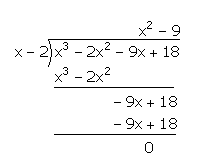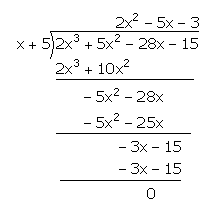A cubic equation refers to any equation containing an x3 term. In order to factorize a cubic equation we must follow the following steps:
Steps to Factorise a Cubic Equation:
- Let p(x) denote the cubic equation.
- Try different values to substitute in place of x for which the resulting value is 0. Suppose you find an ‘a’ such that p(a)=0.
- By the factor theorem, we can conclude that (x-a) is a factor of p(x).
- Perform long division to divide p(x) by (x-a). Let q(x) denote the quotient.
- We have that p(x) = (x-a)q(x). Now the quotient q(x) is a quadratic which can be factorized using the usual method of splitting the middle term.
Example 1: Factorise the cubic polynomial p(x) = x3 – 2x2 – 9x + 18.
Solution: We try various values of x. For example, x=1 gives p(1)=8 which is nonzero and therefore does not work.
Let us now try x=2. We have that p(2)=23 – 2(2)2 – 9(2) + 18 = 0.
So the required value for ‘a’ is 2 and we conclude that x-2 is a factor of p(x). We now perform long division as shown below.

p(x)=x3 – 2x2 – 9x + 18 = (x-2)(x2-9).
x3 – 2x2 – 9x + 18 = (x-2)(x2-32).
x3 – 2x2 – 9x + 18 = (x-2)(x-3)(x+3).
Example 2: Factorise the cubic polynomial p(x) = 2x3 + 5x^2 – 28x – 15.
Solution: As a guess, we substitute x=-5 in the above cubic equation. We have that p(-5)=2(-5)3 + 5(-5)2 – 28(-5) – 15 = 0.
So the required value for ‘a’ is -5 and we conclude that x+5 is a factor of p(x). We now perform long division as shown below.

p(x)=2x3 + 5x2 – 28x – 15 = (x + 5) (2x2 – 5x – 3).
2x3 + 5x2 – 28x – 15= (x + 5) (2x2 – 6x + x – 3).
2x3 + 5x2 – 28x – 15= (x + 5) [2x(x – 3) + 1(x – 3)].
2x3 + 5x2 – 28x – 15 = (x + 5) (2x + 1) (x – 3).